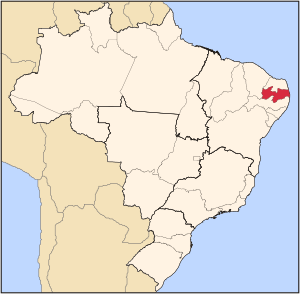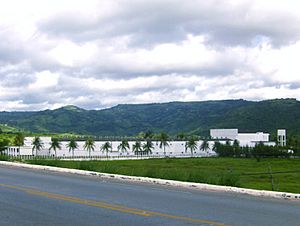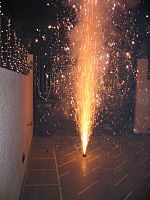Paraíba facts for kids
Quick facts for kids
State of Paraíba
|
|||
|---|---|---|---|
|
|||

Location of State of Paraíba in Brazil
|
|||
| Country | |||
| Capital and Largest City | João Pessoa | ||
| Area | |||
| • Total | 56,584.6 km2 (21,847.4 sq mi) | ||
| Area rank | 21st | ||
| Population
(2012)
|
|||
| • Total | 3,815,171 | ||
| • Rank | 13th | ||
| • Density | 67.42419/km2 (174.62786/sq mi) | ||
| • Density rank | 8th | ||
| Demonym(s) | Paraibano | ||
| GDP | |||
| • Year | 2006 estimate | ||
| • Total | R$ 19,953,000,000 (19th) | ||
| • Per capita | R$ 5,507 (24th) | ||
| HDI | |||
| • Year | 2005 | ||
| • Category | 0.718 – medium (24th) | ||
| Time zone | UTC-3 (BRT) | ||
| • Summer (DST) | UTC-02 (Brasília Summer) | ||
| Postal Code |
58000-000 to 58990-000
|
||
| ISO 3166 code | BR-PB | ||
| Website | pb.gov.br | ||
Paraíba is a state in Brazil. It's located in the northeastern part of the country. Paraíba sits right on the Atlantic Ocean coast. Did you know it's the easternmost point of the Americas? This means it's where the sun rises first! The capital city of Paraíba is João Pessoa.
Contents
Explore Paraíba's Main Cities
- João Pessoa, the state capital
- Campina Grande
- Areia
- Guarabira
- Patos
- Sousa
- Arara
A Look at Paraíba's History
In the mid-1500s, Portuguese settlers arrived from Pernambuco. They founded a city called Filipéia de Nossa Senhora das Neves. Today, this city is known as João Pessoa. It was built at the mouth of the Paraíba do Norte River.
The land in Paraíba was perfect for growing sugarcane. This meant it was great for making sugar. Because of this, the French, the Dutch, and the Portuguese all wanted control of the region. They often fought over it. The Santa Catarina fortress was built near João Pessoa. Its job was to protect the city from the Dutch.
Understanding the Paraíba Flag
The flag of Paraíba has a special meaning. The word nego is Portuguese for "I deny." This word refers to protests that happened in the 1920s. People in Paraíba were protesting against Júlio Prestes becoming the President of Brazil.
The state president, João Pessoa, supported these protests. He joined a group that wanted to change the government. This group helped Getúlio Vargas become president. Sadly, João Pessoa was killed during this time of rebellion.
The official government website of Paraíba explains the flag's colors. The red color stands for the blood of João Pessoa. It reminds people of his killing. The black color represents the mourning period after his death.
Discovering Paraíba Tourmaline
In late 1989, a team led by gemstone hunter Heitor Dimas Barbosa made an amazing discovery. They found some of the most beautiful Tourmaline crystals ever seen. These were found in a small mountain range.
A tiny bit of copper inside the crystals gives them a bright turquoise color. This "neon" blue and blue-green color had never been seen before in tourmalines. These special gems are often called "paraiba tourmaline."
Similar copper-containing tourmalines have been found in other places. These include deposits near Barbosa's mine and in the nearby state of Rio Grande do Norte. Around 2000, a similar gem was found in Nigeria, and in 2005, beautiful crystals were found in Mozambique.
In 2006, experts decided that "paraiba" should describe a type of tourmaline. It does not just mean where it came from. So, "paraiba tourmaline" can now refer to these special gems found in Brazil, Nigeria, and Mozambique. They all have copper and the unique blue-green color.
Paraíba's Economy and Trade

The service sector is the biggest part of Paraíba's economy. It makes up 56.5% of the state's GDP. The industrial sector is next, at 33.1%. Agriculture makes up 10.4% of the GDP (2004).
Paraíba exports many different products. In 2002, its main exports included:
- Woven cotton products (36.3%)
- Footwear (20.1%)
- Sugar and alcohol (10.8%)
- Fish and crustaceans (9.7%)
- Sisal (7%)
- Raw cotton (6.6%)
Paraíba's economy is also strong in making shoes and other leather items. Raising cattle for beef is important too. Growing sugarcane, corn, and beans is also common.
Another big part of the economy is tourism. People love to visit Paraíba's beautiful beaches. They also enjoy ecotourism and fun festivals like "carnaval" and "São João."
Culture and Celebrations
Festa Junina (Saint John Festival)

The Festa Junina is a very popular festival in Northeastern Brazil. The Portuguese brought this celebration to Brazil. It's a big party for St. John's Day, which is on June 24th.
In Brazil, the festivities start after June 12th and last until June 29th. During this time, you can see bonfires and fireworks. People also enjoy folk dancing in the streets.
Festa Junina used to be a festival mostly for people in the countryside. But now, it's a big city event too! People dress up in fun peasant costumes. They dance, enjoy special foods, and have a great time. Bonfires are a very important part of these celebrations.
Carnival
Carnival is a huge party time in Brazil. It happens for four days before Lent, leading up to Ash Wednesday. During Carnival, everyone, rich or poor, forgets their worries. They all join together to party in the streets!
Images for kids
-
Law school of the State University of Paraíba, Campina Grande campus.
-
View of Campina Grande
See also
 In Spanish: Paraíba para niños
In Spanish: Paraíba para niños











